History
 These days, a surgery is performed in comfort, as the patient is under anesthesia, and therefore, feels none of the surgical procedure, at least that is true for most people. There are an unfortunate few for whom anesthesia has little effect. Dr Robert Liston was a pioneering Scottish surgeon, well known for his skills in an era prior to anesthetics, when speed made a difference in terms of pain and survival. For most of us, the idea of a surgery performed in a matter of seconds would not instill much confidence in the doctor…or the procedure, but there was a time when all surgical procedures were performed in this way. People couldn’t take it very long, and the only thing they might have to dull the pain was alcohol…just like we have all seen in the old western movies.
These days, a surgery is performed in comfort, as the patient is under anesthesia, and therefore, feels none of the surgical procedure, at least that is true for most people. There are an unfortunate few for whom anesthesia has little effect. Dr Robert Liston was a pioneering Scottish surgeon, well known for his skills in an era prior to anesthetics, when speed made a difference in terms of pain and survival. For most of us, the idea of a surgery performed in a matter of seconds would not instill much confidence in the doctor…or the procedure, but there was a time when all surgical procedures were performed in this way. People couldn’t take it very long, and the only thing they might have to dull the pain was alcohol…just like we have all seen in the old western movies.
Dr Robert Liston was an expert. He could perform an amputation in seconds. All was going well, and he was a trusted surgeon until 1847, when he was performing an amputation, which he completed in 25 seconds. He was operating so quickly that he accidentally amputated his assistant’s fingers as well. I can only imagine the shock. His was a career filled with skill and excellence, and in an instant, he had a major mistake on his hands.
Dr Liston was famous for his speedy surgeries…often lasting only around 30 seconds. He was well known and respected. In his book “Practical Surgeries,” published in 1837, he emphasizes the importance of quick surgeries, arguing that “these operations must be set about with determination and completed rapidly.” It was all he knew to do. At that time in history, it was the standard of care that everyone expected.
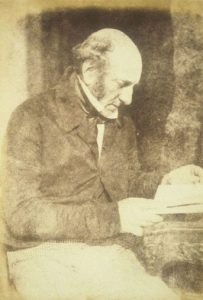
Not everyone believes that the mishap was a true story, and I suppose we will never know, but as the story goes, the case went from bad to worse, when both the patient and the assistant developed sepsis and died. In addition, a spectator reportedly died of shock, meaning that the mortality rate of that one surgery was 300%. While that one surgery was terrible, Dr Liston had many stories of amazing surgeries and miraculous successes. Nevertheless, this one surgery was his most famous. There is a saying by Michael Josephson that goes like this, “We judge ourselves by our best intentions and most noble deeds, but we will be judged by our worst act.” That worst act doesn’t necessarily have to be intentional, and in fact most “worst acts” aren’t intentional. Liston was a good surgeon, and even if he did have this mishap, his overall mortality rate was actually impressive compared to his peers…especially when you consider the speed factor. According to historian Richard Hollingham, “of the 66 patients Liston operated between 1835 and 1840, only 10 died – a death rate of only around 16%.”
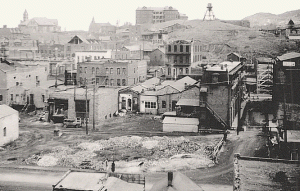 For many years my husband’s Aunt Marian and Uncle John Kanta lived in Helena, Montana. Some of their kids still do, but they didn’t live there in 1935, when on October 18th, a magnitude 6.2 earthquake struck at 10:48pm. The quake had its epicenter right near Helena and it had a maximum perceived intensity of VIII (Severe) on the Mercalli intensity scale. The quake on that date was the largest of a series of earthquakes that also included a large aftershock on October 31 of magnitude 6.0 and a maximum intensity of VIII. Two people died in the first quake, and two others died as a result of the October 31 aftershock. Property damage was over $4 million.
For many years my husband’s Aunt Marian and Uncle John Kanta lived in Helena, Montana. Some of their kids still do, but they didn’t live there in 1935, when on October 18th, a magnitude 6.2 earthquake struck at 10:48pm. The quake had its epicenter right near Helena and it had a maximum perceived intensity of VIII (Severe) on the Mercalli intensity scale. The quake on that date was the largest of a series of earthquakes that also included a large aftershock on October 31 of magnitude 6.0 and a maximum intensity of VIII. Two people died in the first quake, and two others died as a result of the October 31 aftershock. Property damage was over $4 million.
Helena is a pretty city that lies in a valley in western Montana. It lies within the northern part of the Intermountain Seismic Belt (ISB). I didn’t know it then, but this is an area of relatively intense seismicity. It runs from northwestern Arizona, through Utah, Idaho, and Wyoming, before dying out in northwestern Montana. In the area near Helena, it turns to the northwest, where it intersects with the Lewis and Clark fault zone. The Helena earthquake sequence actually began October 3, 1935, with a small earthquake. That quake was followed by a damaging earthquake on October 12th, a magnitude 5.9, intensity VII. That wasn’t the mainshock, however. That one occurred on October 18th, a magnitude 6.2, intensity VIII. A lesser shock followed on October 31st, a magnitude 6.0, intensity VIII, and a further large aftershock on November 28th, a magnitude 5.5, intensity VI. These were just the mainshocks. There were also a total of 1800 tremors recorded 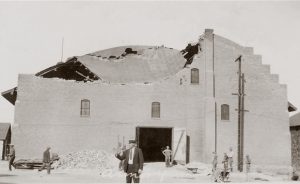 between October 4, 1935 and April 30, 1936. The people of Helena either got used to the shaking, which I can’t imagine, or they were terrified with every tremor, which makes more sense to me.
between October 4, 1935 and April 30, 1936. The people of Helena either got used to the shaking, which I can’t imagine, or they were terrified with every tremor, which makes more sense to me.
The damage to the unreinforced buildings of that era was widespread, with more than 200 chimneys destroyed in the city of Helena. At that time, little was known about reinforcement of buildings in earthquake prone areas. The northeast part of the city, where buildings were constructed on alluvial soil, and in the southern business district, which contained many brick buildings, saw the strongest effects. Alluvial soil is highly porous, which would explain the soil liquification that took place. The most extensively damaged building was the Helena High School, which was completed in August 1935 and had just been dedicated in early October. The school buildings, which had cost $500,000, had not been designed to be earthquake resistant. Another building that was totally destroyed and had to be rebuilt was the Lewis and Clark County Hospital. The October 18 earthquake caused an estimated $3 million of damage to property. The aftershock of October 31 caused further damage estimated at $1 million, particularly to structures already weakened by the October 18 shock. Two people were killed by falling bricks in Helena during the October 18 shock. Two brick masons died as while removing a brick tower during the October 31 aftershock.
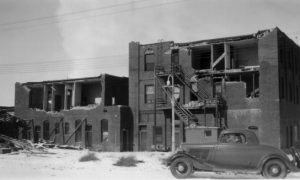 The Red Cross and Federal Emergency Relief Administration set up emergency camps for those displaced by the quake on land at the Montana Army National Guard’s Camp Cooney. Approximately 400 people stayed there the first night, but most had found space with friends or family outside of the damaged area by the end of the week. Some people were too afraid of continued shocks to stay in a house, and they stayed in tents for the next few weeks. The National Guard was deployed in Helena to keep sightseers away from the damaged buildings, and either because of the guard or the good moral values of the people, there was no looting. It is believed that in today’s world, the damages would have been in the $500 million range.
The Red Cross and Federal Emergency Relief Administration set up emergency camps for those displaced by the quake on land at the Montana Army National Guard’s Camp Cooney. Approximately 400 people stayed there the first night, but most had found space with friends or family outside of the damaged area by the end of the week. Some people were too afraid of continued shocks to stay in a house, and they stayed in tents for the next few weeks. The National Guard was deployed in Helena to keep sightseers away from the damaged buildings, and either because of the guard or the good moral values of the people, there was no looting. It is believed that in today’s world, the damages would have been in the $500 million range.
 Prisoners have tried to escape ever since there have been prisons. It is the nature of the situation. No one likes to be locked up. Most escape attempts are not successful, and few are what we would consider well planned, but in the case of Florida prison inmates, Charles Walker and Joseph Jenkins, some kind of good planning must have gone into the escape plan. The two men were serving life sentences, without the possibility of parole, for murder, and so I guess they had nothing to lose by getting caught in an escape attempt. Jenkins was incarcerated for a 1998 murder and armed robbery and a 1997 auto theft. He has been in prison since 2000. Walker was imprisoned for a 1999 murder and has been in custody since 2001.
Prisoners have tried to escape ever since there have been prisons. It is the nature of the situation. No one likes to be locked up. Most escape attempts are not successful, and few are what we would consider well planned, but in the case of Florida prison inmates, Charles Walker and Joseph Jenkins, some kind of good planning must have gone into the escape plan. The two men were serving life sentences, without the possibility of parole, for murder, and so I guess they had nothing to lose by getting caught in an escape attempt. Jenkins was incarcerated for a 1998 murder and armed robbery and a 1997 auto theft. He has been in prison since 2000. Walker was imprisoned for a 1999 murder and has been in custody since 2001.
The men were serving their time in a Panhandle prison called Franklin Correctional Institution in Carrabelle, Florida. accidentally released two inmates from a Panhandle prison who are convicted murderers, according to published reports. Somehow, Walker and Jenkins, both 34, were able to obtain fraudulent orders of sentence modification. Based on those modifications, Jenkins was released on September 27, 2013, and Walker was released on October 8, 2013. Both were former residents of Orlando. Their release was apparently “in accordance with Department of Corrections policy and procedure. However, both of their releases were based on fraudulent modifications that had been made to court orders,” Department of Corrections secretary Michael Crews said.
The judge whose name is on the forged documents is Belvin Perry, Orange County chief judge, who presided  over the Casey Anthony case. Perry’s office said that the judge’s signature was forged in the paperwork calling for reduced sentences for the convicted killers. Apparently, however, while the false documents had problems the one thing that was correct was the judges signature. The judge denies any wrongdoing, saying “It is quite evident that someone forged a court document, filed a motion, and that someone with the aid of a computer, lifted my signature off previous signed documents, which are public reports, affixed that to the document, sent it to the clerk’s office. It was processed and forwarded to doc and the defendant ended up being released,” Perry maintains. He also says, “I have never seen anything like this. You have to give them an A for being imaginative and effective.” The reality is that this was not the first time a prisoner managed to obtain false documents, and probably wont be the last, since no one was caught in this act. The prison waited 17 days before notifying the authorities of the escape. Cybercrime is the newest thing. Easy to perform, hard to catch.
over the Casey Anthony case. Perry’s office said that the judge’s signature was forged in the paperwork calling for reduced sentences for the convicted killers. Apparently, however, while the false documents had problems the one thing that was correct was the judges signature. The judge denies any wrongdoing, saying “It is quite evident that someone forged a court document, filed a motion, and that someone with the aid of a computer, lifted my signature off previous signed documents, which are public reports, affixed that to the document, sent it to the clerk’s office. It was processed and forwarded to doc and the defendant ended up being released,” Perry maintains. He also says, “I have never seen anything like this. You have to give them an A for being imaginative and effective.” The reality is that this was not the first time a prisoner managed to obtain false documents, and probably wont be the last, since no one was caught in this act. The prison waited 17 days before notifying the authorities of the escape. Cybercrime is the newest thing. Easy to perform, hard to catch.
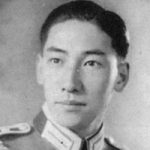 Yang Kyoungjong was a Korean man with an incredible story. In 1938, when he was 18 years old, Kyoungjong was in Manchuria when he was forced into the Kwantung Army of the Imperial Japanese Army to fight against the Soviet Union. It was the outbreak of World War II, and I suppose the Japanese decided they would be better off to make him soldier than to let him languish in a prisoner of war camp. So, fight he did. Korea was ruled by Japan at that time, and Kyoungjong really had no choice to to follow orders.
Yang Kyoungjong was a Korean man with an incredible story. In 1938, when he was 18 years old, Kyoungjong was in Manchuria when he was forced into the Kwantung Army of the Imperial Japanese Army to fight against the Soviet Union. It was the outbreak of World War II, and I suppose the Japanese decided they would be better off to make him soldier than to let him languish in a prisoner of war camp. So, fight he did. Korea was ruled by Japan at that time, and Kyoungjong really had no choice to to follow orders.
During the Battle of Khalkhin Gol, things weren’t going well for the Japanese army, and Kyoungjong was again captured…this time by the Soviet Red Army. He was sent to a Gulag labor camp. While he was there, and with Soviet manpower shortages being what they were, Kyoungjong was presses into service in the Soviet army in 1942. He, along with thousands of other prisoners, were told to fight with the Red Army against Nazi Germany. He was sent to the Eastern Front of Europe.
Somehow, Kyoungjong managed to always be in the wrong place at the wrong time. In 1943, he was once again captured, this time by the Wehrmacht soldiers in eastern Ukraine during the Third Battle of Kharkov. He  was pressed into service again, and told that he had joined the “Eastern Battalions” to fight for Germany. Kyoungjong was sent to Occupied France to serve in a battalion of former Soviet prisoners of war on the Cotentin peninsula in Normandy, close to Utah Beach. I’m sure he wondered which army he was really a part of.
was pressed into service again, and told that he had joined the “Eastern Battalions” to fight for Germany. Kyoungjong was sent to Occupied France to serve in a battalion of former Soviet prisoners of war on the Cotentin peninsula in Normandy, close to Utah Beach. I’m sure he wondered which army he was really a part of.
During the D-Day landings in northern France by the Allied forces, Kyoungjong was captured by paratroopers of the United States Army in June 1944. The American Army thought he was a Japanese soldier in German uniform at first. At the time, Lieutenant Robert Brewer of the 506th Parachute Infantry Regiment, 101st Airborne Division, reported that his regiment had “captured four Asians in German uniform after the Utah Beach landings, and that initially no one was able to communicate with them.” The good news for Kyoungjong was that he was not going to again be expected to fight with a different army. He was first sent to a prison camp in Britain and later transferred to a camp in the United States.
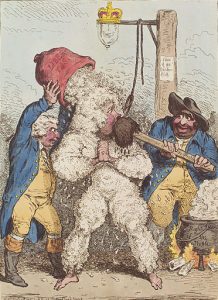 I think most of us have heard of being “tarred and feathered,” as a form of punishment, but we may not really know how much of a punishment it really was. When we think about it, the show, “Home Alone” might come to mind. Of course, some kind of syrup and then the feathers, but that does not really even begin to describe the real act of tarring and feathering.
I think most of us have heard of being “tarred and feathered,” as a form of punishment, but we may not really know how much of a punishment it really was. When we think about it, the show, “Home Alone” might come to mind. Of course, some kind of syrup and then the feathers, but that does not really even begin to describe the real act of tarring and feathering.
In 1776 in Norfolk, Virginia, Captain William Smith was tarred and feathered by a mob which actually included the mayor of Norfolk apparently!! Mobs are never a good thing. They are always out of control, and people who might normally be pretty decent, are dragged into things they might never do otherwise. Captain Smith was suspected of sharing secrets about a local ship owner John Gilcrest smuggling goods, with British officials. It was a terrible offence, but remember that he was “suspected” of this, not convicted. That is the problem with the mobs. They often take matters into their own hands…Vigilante Justice…whether the person is really guilty or not.
Tar and Feather was a medieval form of torture and humiliation. It involved stripping the victim up to his waist, applying tar on his body, and covering him with feathers. That wasn’t the end of it though. The victim was then put on a cart and paraded around the place. Sometimes, the tar was simply poured on the victim’s body and he was made to roll on feathers. This isn’t like syrup or the asphalt tar of today. The tar they used was likely from the pine tar the Colonies were accustomed to distilling for its use on preserving the wood of ships from rot. Hot asphalt tar would critically burn the body. Pine creates charcoal and pine tar when heated up. This pine tar is naturally a sticky substance making it a perfect material for applying to someone who is about to be covered in  feathers. While that explains why there were no casualties of this form of punishment. Nevertheless, the job of removing the dried pine tar and feathers off the skin was extremely painful.
feathers. While that explains why there were no casualties of this form of punishment. Nevertheless, the job of removing the dried pine tar and feathers off the skin was extremely painful.
After Captain Smith was humiliated by the application of his feathery outfit, he was thrown into the harbor. He almost drowned before being rescued by a passing ship, just as his strength was giving out. He survived, and was later quoted as saying that “…[they] dawbed my body and face all over with tar and afterwards threw feathers on me.” As with most other tar and feathers victims in the decade that followed, Smith was suspected of informing on smugglers to the British Customs service. The punishment was harsh, and it was swift. The colonies were trying to gain their freedom, and that meant that they would fight to the death, and they would never tolerate traitors. I don’t know if Captain Smith was a traitor or not, but no one was ever punished for what they did to him, so there is that.
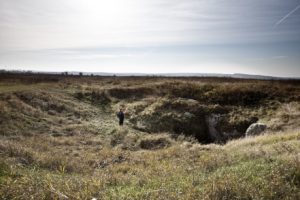 During World War II, and Jews who didn’t want to entrust their survival to the Nazis, had to make a way of escape or find a place to hide. For those who hoped against hope that the Nazis didn’t really hate them, or that the war would end very soon, the chance to escape came and went before they had really given the situation much thought. This was especially true for the Jewish people who had been born in the countries they now found themselves outcasts of.
During World War II, and Jews who didn’t want to entrust their survival to the Nazis, had to make a way of escape or find a place to hide. For those who hoped against hope that the Nazis didn’t really hate them, or that the war would end very soon, the chance to escape came and went before they had really given the situation much thought. This was especially true for the Jewish people who had been born in the countries they now found themselves outcasts of.
Zaida Stermer, his wife Esther, and their six children, of Korolowka, Ukraine, dug up the last of their possessions from behind their house, loaded their wagons with food and fuel, and drove away into the darkness. It was October 12, 1942. The Stermers weren’t alone. Traveling with them were about two dozen friends and family members, all Jews…and all in a lot of trouble. They had almost waited too long, and now the Nazis were out to kill all the Jews in the village. Ukraine had been under German occupation for about a year by then, and they had hoped that the war would end, and they could get back to their lives, but instead, the situation was exploding, and they had to get out while they still could.
The group made their way quietly about 5 miles to the north of town. With the Nazi “roundups and mass executions” of Ukrainian Jews in full swing, they were headed to a dirt road that ended at a sinkhole. There they made their way into a summertime tourist attraction known as the Verteba cave. They knew this was only  going to be a temporary solution, because in the summer, the tourists would be back, and they would be discovered. They hoped they had until summer.
going to be a temporary solution, because in the summer, the tourists would be back, and they would be discovered. They hoped they had until summer.
Modern cave explorers would not consider going underground without reliable light sources, technical and safety gear, navigation experience, clothing to stave off hypothermia, and of course an adequate supply of food and fresh water. The Stermers and their little band of survivors had none of these things. They went in in the dark, and had no light in the morning either. They fumbled their way further and further into the cave, hoping they could find there way back out. The cave had little ventilation and no real water supply, except what seeped through the rocks. Cooking was dangerous, and they almost lost a child to smoke inhalation. They moved the cooking further into the cave where they found better ventilation. Then came the worst night of all…
They had been in Verteba about four weeks, and thinking they might make it when their optimism was shattered. Suddenly in the dark they heard the sound of boots, and the rattling of guns. Someone yelled in Yiddish, “The Germans are here!! They’ve discovered us!!” Just as suddenly, and before anyone could think twice, Ester spoke up, “Very well, so you have found us. What do you think? Do you think that unless you kill us the Fuhrer will lose the war? Look at how we live her, like rats. All we want is to live, to survive the war years. Leave us here.” She was stalling!! She was allowing the others time to escape. As the stunned Germans listened to this little lady, the others hurried to the escape route they had found earlier. In the end, the  Germans only got eight of the cave dwelling Jews. Miraculously, Esther escaped. They hid out with friends throughout April 1943, but things were heating up again, and Esther told her family, “We are not going to the slaughterhouse.” She said to her son, Nissel, “Go to the forest, find a hole, anything.” It was thanks to Nissel that the family survived. Nissel located the cave known as the Priest’s Grotto. It was thought that the world record for living underground was 205 days, but the true record was set by the women and children who survived the Priest’s Grotto, by living completely underground for 344 days without seeing the outside world. It was a tough way to live, but they did survive, and that is a miracle.
Germans only got eight of the cave dwelling Jews. Miraculously, Esther escaped. They hid out with friends throughout April 1943, but things were heating up again, and Esther told her family, “We are not going to the slaughterhouse.” She said to her son, Nissel, “Go to the forest, find a hole, anything.” It was thanks to Nissel that the family survived. Nissel located the cave known as the Priest’s Grotto. It was thought that the world record for living underground was 205 days, but the true record was set by the women and children who survived the Priest’s Grotto, by living completely underground for 344 days without seeing the outside world. It was a tough way to live, but they did survive, and that is a miracle.
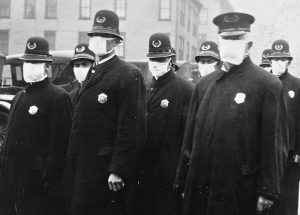 As the Covid-19 Pandemic has spread across our nation, so has the battle for or against the wearing of face masks. Part of the problem has been the conflicting analysis as to the value of the masks between one doctor and another, one politician and another, or even the same doctor at different times during the crisis. Many states, cities, and even establishments have rules about wearing a mask, with varied levels of enforcement. Of course, we were told to “shelter in place” and close any “non-essential” businesses, a catastrophic event for the economy. Everything from schools to bars, and theaters to salons was closed. Cities became virtual ghost towns, and things like Facebook and Twitter, Zoom and Google Classroom, texting and phone calls became vital. People’s sanity began to take a hit, and loneliness became the norm…especially for anyone who lived alone.
As the Covid-19 Pandemic has spread across our nation, so has the battle for or against the wearing of face masks. Part of the problem has been the conflicting analysis as to the value of the masks between one doctor and another, one politician and another, or even the same doctor at different times during the crisis. Many states, cities, and even establishments have rules about wearing a mask, with varied levels of enforcement. Of course, we were told to “shelter in place” and close any “non-essential” businesses, a catastrophic event for the economy. Everything from schools to bars, and theaters to salons was closed. Cities became virtual ghost towns, and things like Facebook and Twitter, Zoom and Google Classroom, texting and phone calls became vital. People’s sanity began to take a hit, and loneliness became the norm…especially for anyone who lived alone.
It’s been a grim time, but it isn’t the first time. During the 1918 Spanish Flu Pandemic, mask wearing started with the first masks being made out of gauze, which was quite porous. Still, in an effort to stop the spread, or as we would say these days, flatten the curve, all the people were now asked to wear masks. In fact, in the Fall of 1918, it became mandatory. With the second surge in December 1918, new restrictions went into place. The January 1919 ordinance had a much larger impact in creating resistance to wearing a mask in public by American citizens. However, it too was short lived, and on February 1, 1919 the city ordinance requiring every citizen of San Francisco going out in public to wear masks was voted down. The mandatory mask laws for COVID-19 are not new. This has already happened twice in American history and if you do feel strongly about not wearing one, it has been protested successfully before in a pandemic caused by a much deadlier virus.
I don’t believe the resistance, with was called the Anti-Mask League of San Francisco fell along party lines, like 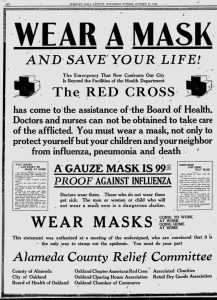 much of today’s resistance seems to be, but were rather a diverse bunch of individuals with varying professional backgrounds. Its members included physicians, libertarians, and many others. Many of the same arguments we have today, were in place then, and it is debatable as to whether or not the masks of today are any better than the ones back then…with the possible exception of the medical grad hazard wear, the N-95 mask, and the Head gear. Pretty much everything we’ve tried with Covic-19 was also used in 1918 to try to prevent the spread of the flu…close schools, wear masks, don’t cough or sneeze in someone’s face, avoid large events and hold them outside when possible, and of course, no spitting. There were many ways to get the word out, like in Philadelphia, where streetcar signs warned “Spit Spreads Death.” In New York City, officials enforced no-spitting ordinances and encouraged residents to cough or sneeze into handkerchiefs (a practice that caught on after the pandemic). The city’s health department even advised people not to kiss “except through a handkerchief,” and wire reports spread the message around the country. I don’t know…does any of this sound familiar to you, because it sure does to me. I guess there really is nothing new under the sun. In western states, some cities even called mask ordinances a patriotic duty. In October 1918, the San Francisco Chronicle ran a public service announcement telling readers that “The man or woman or child who will not wear a mask now is a dangerous slacker.” This was in reference to the type of World War I “slacker” who didn’t help the war effort. One sign in California threatened, “Wear a Mask or Go to Jail.” The PSA in the Chronicle appeared on October 22, just over a week before San Francisco had scheduled its mask ordinance to begin on November 1. It was signed by the mayor, the city’s board of health, the American Red Cross and several other departments and organizations, and it was very clear about its message: “Wear a Mask and Save Your Life!”
much of today’s resistance seems to be, but were rather a diverse bunch of individuals with varying professional backgrounds. Its members included physicians, libertarians, and many others. Many of the same arguments we have today, were in place then, and it is debatable as to whether or not the masks of today are any better than the ones back then…with the possible exception of the medical grad hazard wear, the N-95 mask, and the Head gear. Pretty much everything we’ve tried with Covic-19 was also used in 1918 to try to prevent the spread of the flu…close schools, wear masks, don’t cough or sneeze in someone’s face, avoid large events and hold them outside when possible, and of course, no spitting. There were many ways to get the word out, like in Philadelphia, where streetcar signs warned “Spit Spreads Death.” In New York City, officials enforced no-spitting ordinances and encouraged residents to cough or sneeze into handkerchiefs (a practice that caught on after the pandemic). The city’s health department even advised people not to kiss “except through a handkerchief,” and wire reports spread the message around the country. I don’t know…does any of this sound familiar to you, because it sure does to me. I guess there really is nothing new under the sun. In western states, some cities even called mask ordinances a patriotic duty. In October 1918, the San Francisco Chronicle ran a public service announcement telling readers that “The man or woman or child who will not wear a mask now is a dangerous slacker.” This was in reference to the type of World War I “slacker” who didn’t help the war effort. One sign in California threatened, “Wear a Mask or Go to Jail.” The PSA in the Chronicle appeared on October 22, just over a week before San Francisco had scheduled its mask ordinance to begin on November 1. It was signed by the mayor, the city’s board of health, the American Red Cross and several other departments and organizations, and it was very clear about its message: “Wear a Mask and Save Your Life!”
“Red Cross headquarters in San Francisco made 5,000 masks available to the public at 11:00am, October 22. By noon it had none,” wrote the late historian Alfred W Crosby in America’s Forgotten Pandemic: The Influenza of 1918. “By noon the next day Red Cross headquarters had dispensed 40,000 masks. By the twenty-sixth 100,000 had been distributed in the city… In addition, San Franciscans were making thousands for themselves.” Lasting from February 1918 to April 1920, the Spanish Flu Pandemic infected 500 million people…about a third 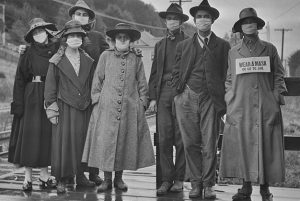 of the world’s population at the time, in four successive waves. The death toll is typically estimated to have been somewhere between 17 million and 50 million, and possibly as high as 100 million, making it one of the deadliest pandemics in human history. With all the safeguards, and the lack of success in “stopping the spread,” I guess it is up to each individual to decide on the effectiveness, or the lack thereof, concerning the safeguards that were put in place. To me, it seems that we have done pretty much the same things today as they did in 1918, so only time will tell us if they were successful, or a waste of time and money. Still, since the Spanish Flue had 4 waves, it doesn’t seem like we successfully stopped anything.
of the world’s population at the time, in four successive waves. The death toll is typically estimated to have been somewhere between 17 million and 50 million, and possibly as high as 100 million, making it one of the deadliest pandemics in human history. With all the safeguards, and the lack of success in “stopping the spread,” I guess it is up to each individual to decide on the effectiveness, or the lack thereof, concerning the safeguards that were put in place. To me, it seems that we have done pretty much the same things today as they did in 1918, so only time will tell us if they were successful, or a waste of time and money. Still, since the Spanish Flue had 4 waves, it doesn’t seem like we successfully stopped anything.

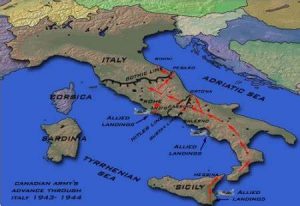 During World War II, when Japan was the enemy, and the United States just happened to have a Japanese population of between 110,000 and 120,000 people of Japanese ancestry. The government decided to place these people in internment camps, mainly because they were not sure of their loyalty. Sixty-two percent of the internees were United States citizens, but somehow that didn’t matter. The American people and the government were afraid of them. Maybe it made no sense, but there it was.
During World War II, when Japan was the enemy, and the United States just happened to have a Japanese population of between 110,000 and 120,000 people of Japanese ancestry. The government decided to place these people in internment camps, mainly because they were not sure of their loyalty. Sixty-two percent of the internees were United States citizens, but somehow that didn’t matter. The American people and the government were afraid of them. Maybe it made no sense, but there it was.
While their families were interned in camps at home, a group of Japanese-Americans, were serving their country as members of the 100th Infantry Battalion and the 442nd Infantry Regiment. The 100th Infantry Battalion was composed mainly of Nisei…the American born children of Japanese immigrants. They were fighting for the allies on the Western Front of World War II. While the American people did not trust the Japanese immigrants or their children, this unit, out of all units of comparable size and length of service, the 442nd Regimental Combat Team (RCT) is, to this day, the most decorated unit in American military history.
Most of the men in the 100th Infantry Battalion were former Nisei members from the Hawaii National Guard. These brave men fought to capture the fortress of Monte Cassino in Italy. It was in this battle that the 100th Infantry Battalion first earned the nickname “Purple Heart Battalion.” The battle to capture the fortress of Monte Cassino was an important stage in the offensive to liberate Rome from Axis leaders. The 100th Infantry Battalion later became incorporated into the 442nd RCT, which drew most of its forces from mainland Nisei volunteers, after the regiment arrived in Europe.
During the war, one battle stood out…at least in my mind. It was one that proves without a doubt, the extreme loyalty and courage of this unit. Among their other military accomplishments, the 442nd RCT was instrumental in the rescue of the “Lost Battalion.” In a daring last-ditch effort, members of the 442nd RCT were ordered to rescue a battalion of Texans surrounded by German troops in the Vosges Mountains of eastern France. Although the Nisei knew that they would suffer heavy casualties, many saw the mission as a chance to prove their loyalty. The regiment was also critical in the breach of the Gothic Line. Embedded within the Apennine 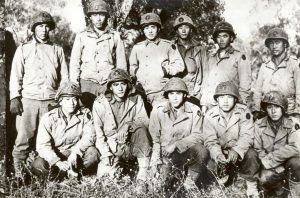
 Mountains, it was Germany’s last major line of defense in the Italian Campaign. Later, members of the regiment were present at the liberation of the infamous Dachau concentration camp in Germany. For some of the soldiers, the experience was a bittersweet one; although they were able to emancipate the prisoners of the camp, they could not help but remember their detained families at home.
Mountains, it was Germany’s last major line of defense in the Italian Campaign. Later, members of the regiment were present at the liberation of the infamous Dachau concentration camp in Germany. For some of the soldiers, the experience was a bittersweet one; although they were able to emancipate the prisoners of the camp, they could not help but remember their detained families at home.
 I am always amazed at the lengths nations will go to try to have a better weapon with which to war against their enemies. Some of the weapons were horrifically great successes, while others only succeeded in being amusingly unsuccessful. It seems that the Germans were famous for trying to come up with unusual ideas for weaponry. In fact, World War II seemed to be full of bizarre weapons.
I am always amazed at the lengths nations will go to try to have a better weapon with which to war against their enemies. Some of the weapons were horrifically great successes, while others only succeeded in being amusingly unsuccessful. It seems that the Germans were famous for trying to come up with unusual ideas for weaponry. In fact, World War II seemed to be full of bizarre weapons.
Wars always present opportunities for technological development, but Germany seemed to be particularly motivated to pour considerable resources into weapons projects. The level of success, varied with the weapons. That is not unusual, as weapons go, but I think that when you look some of the bizarre weapon designs that Germany came up with really seemed like a recipe for calamity to me. The weapons they came up with had varying degrees of success. The Germans developed the V-2 rocket, which both rained destruction on the United Kingdom and jumpstarted the space race. On the other hand, they also tried to build a “sun gun,” an orbital heat ray that was supposed to use reflected sunlight to torch cities.
The V-3 cannon project falls in the middle of the spectrum of weaponry. In the end, it never threatened the Allied powers, but if it had been given more production time, it very well could have. The V-3 was an extremely long artillery piece, over 430 feet in length. It was designed to fire projectiles up to a distance of 100 miles away. The V-3 cannon was built to bombard British cities from mainland Europe, bypassing the need for planes or the V-2. These enormous guns had been in development since World War I, on both sides of the conflict, but to this point these weapons hadn’t been deployed in combat. The problem was that the size of an explosion needed to propel a projectile over such a distance was so large that it would quickly destroy any gun barrel. They just couldn’t get that part fixed.
At the outbreak of World War II, the Germans rediscovered the plans for the V-3 and began to research them 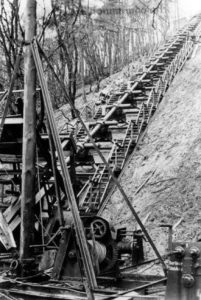 again. In 1943, Hitler restarted the V-3 project under his Armaments and War Procurement Minister, Albert Speer. The first goal was to solve the explosion problem. It was decided that the V-3 would use several small explosions that would propel the projectile along the barrel. Even with that change, the barrel was so large and unwieldy that it couldn’t be aimed. It had to be built already aiming at the intended target, and the target had to be the size of a city. That is a tall order.
again. In 1943, Hitler restarted the V-3 project under his Armaments and War Procurement Minister, Albert Speer. The first goal was to solve the explosion problem. It was decided that the V-3 would use several small explosions that would propel the projectile along the barrel. Even with that change, the barrel was so large and unwieldy that it couldn’t be aimed. It had to be built already aiming at the intended target, and the target had to be the size of a city. That is a tall order.
The Germans made plans to build 50 V-3 cannons on the French coastline, but RAF bombings delayed the project. When the Allies retook France in 1944, the V-3 project was again abandoned. The Allies didn’t learn of the V-3 project until after World War II had ended. Winston Churchill said that “if the guns had been completed, they could have devastated England more than any other German weapon.” Thankfully the Allies retook France in time to avoid such a disaster.
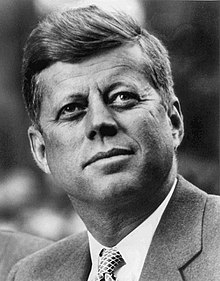
 For anyone alive and of an age to remember it, the 1950s and 1960s brought with them a strange new reality. I can’t say that I fully understood it all at that time, but I remember our school having a “Fallout Shelter.” They were also called a “Bomb Shelter” in some places, and the purpose was to protect the population from exposure to the fallout from a nuclear explosion. I suppose that if I had understood more about what these were, I might have been scared, but I just remember thinking it a strange idea, and highly unlikely. It did occur to me that if a bomb to explode, it would be unlikely that we would all have time to get to the school for protection.
For anyone alive and of an age to remember it, the 1950s and 1960s brought with them a strange new reality. I can’t say that I fully understood it all at that time, but I remember our school having a “Fallout Shelter.” They were also called a “Bomb Shelter” in some places, and the purpose was to protect the population from exposure to the fallout from a nuclear explosion. I suppose that if I had understood more about what these were, I might have been scared, but I just remember thinking it a strange idea, and highly unlikely. It did occur to me that if a bomb to explode, it would be unlikely that we would all have time to get to the school for protection.
Apparently, President John F. Kennedy, agreed with me on that thought, because, when he was speaking on civil defense on October 6, 1961, he advised American families to build bomb shelters to protect them from atomic fallout in the event of a nuclear exchange with the Soviet Union. We were, after all, in the middle of the Cold War, and neither side really knew if the other side would decide that they needed to start that latest, deadly type of war with the other side. Looking back, many people aren’t sure that a home-made bomb shelter would really be able to protect the occupants from the fallout of an atomic bomb. No one can really say for sure that the government-built shelters in schools and churches could either, in retrospect.
Still, prudent minds assumed that something needed to be done. Kennedy also assured the public that the United States civil defense program would soon begin providing such protection for every American. What seemed like science fiction, became a grim possibility just one year later, when true to Kennedy’s concerns, the world hovered on the brink of full-scale nuclear war when the Cuban Missile Crisis erupted over placement of nuclear missiles in Cuba by the USSR. Of course, panic ensues. The crisis lasted for 13 days, but some Americans prepared for nuclear war by buying up canned goods and completing last-minute work on their backyard bomb shelters. In the end, of course, it all ended without. After several days of tense negotiations, Kennedy and Khrushchev reached an agreement. Publicly, the Soviets would dismantle their offensive weapons in Cuba and return them to the Soviet Union, subject to United Nations verification, in exchange for a US public 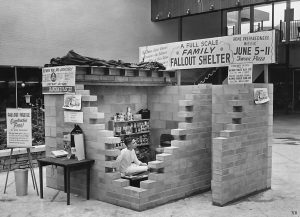
 declaration and agreement to avoid invading Cuba again. The Kennedy administration had been publicly embarrassed by the failed Bay of Pigs Invasion in April 1961, which had been launched under President John F Kennedy by CIA-trained forces of Cuban exiles. Afterward, former President Dwight Eisenhower told Kennedy that “the failure of the Bay of Pigs will embolden the Soviets to do something that they would otherwise not do.” He was right, but for now, disaster was averted.
declaration and agreement to avoid invading Cuba again. The Kennedy administration had been publicly embarrassed by the failed Bay of Pigs Invasion in April 1961, which had been launched under President John F Kennedy by CIA-trained forces of Cuban exiles. Afterward, former President Dwight Eisenhower told Kennedy that “the failure of the Bay of Pigs will embolden the Soviets to do something that they would otherwise not do.” He was right, but for now, disaster was averted.

